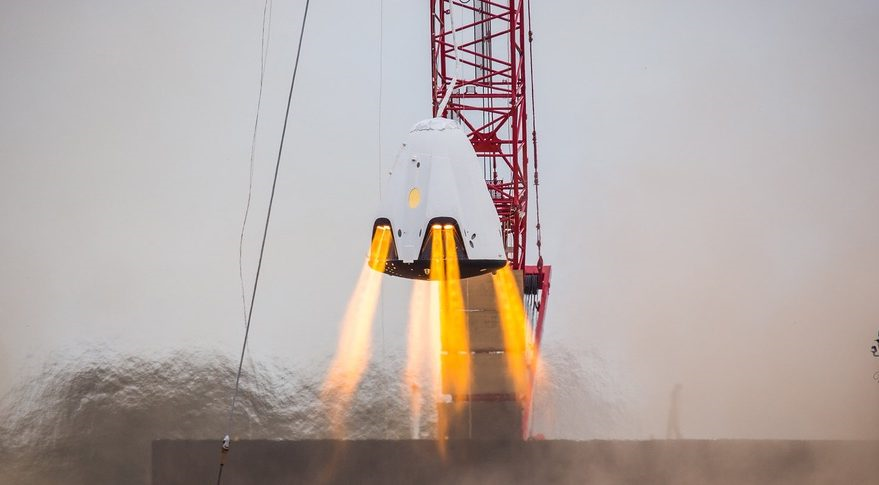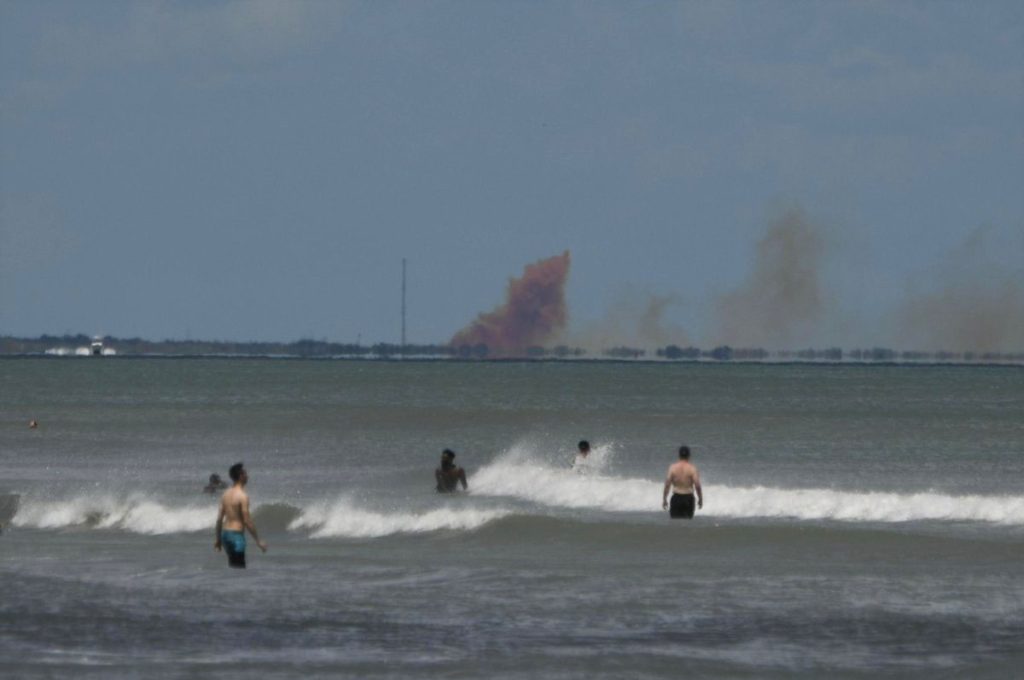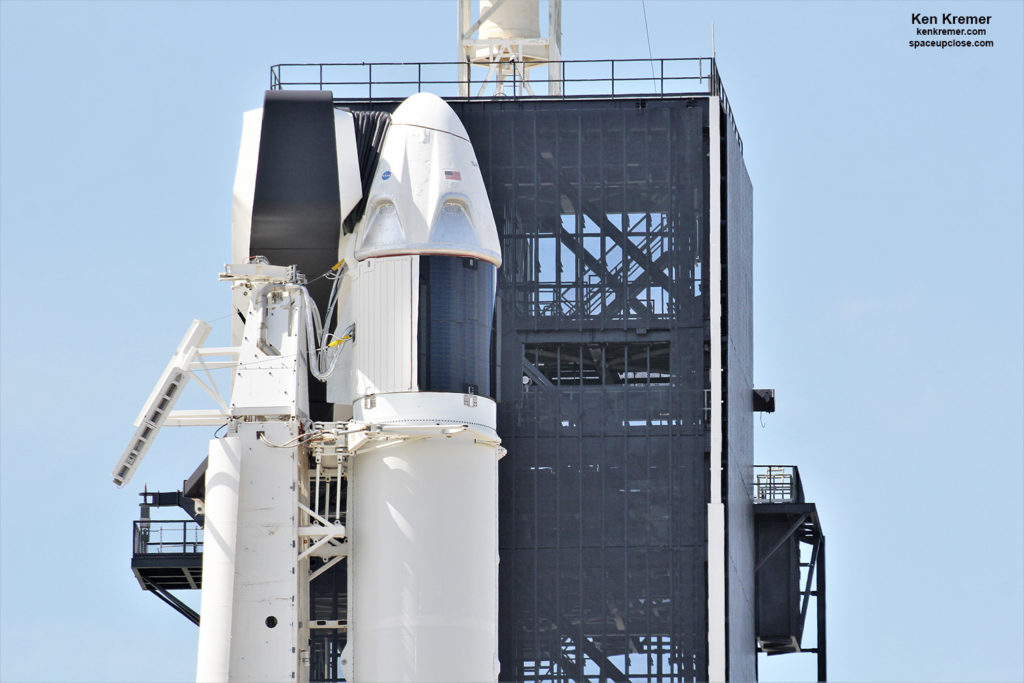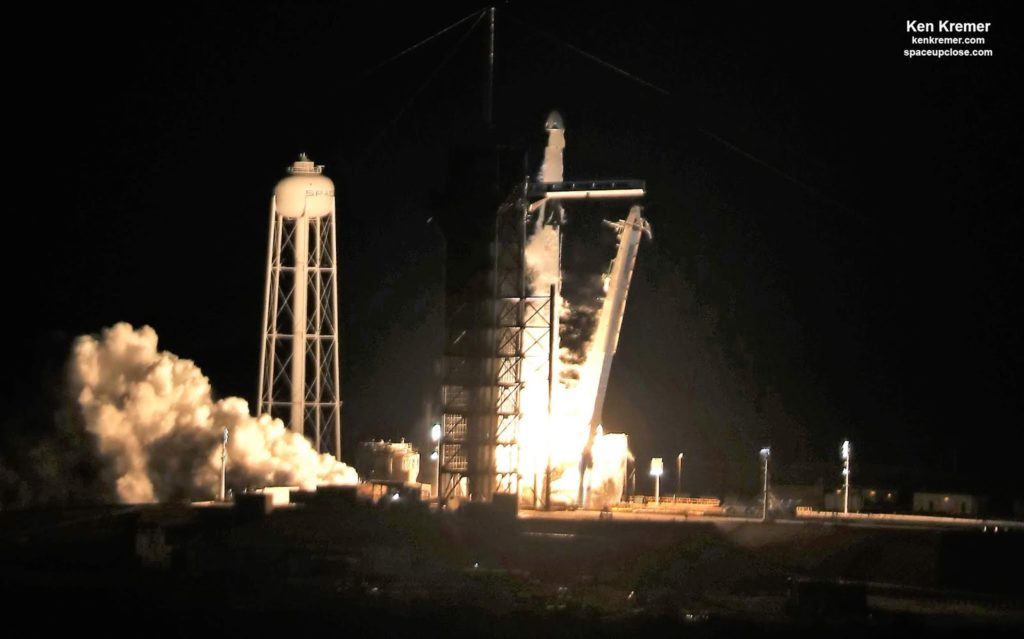Koenigsmann, SpaceX’s Vice President of build and flight reliability.
Furthermore there is no realistic timetable yet for a resumption of Crew Dragon missions to the International Space Station (ISS).
 |
|
SpaceX Crew Dragon test vehicle undergoes testing of SuperDraco thrusters at McGregor, Texas facility. Credit: SpaceX
|
The explosion of the Demo-1 Crew Dragon vehicle occurred during the initial test of the Super Draco abort thrusters on April 20, following a successful series of tests of the Draco thrusters on a test stand at Landing Zone-1 at the Cape, explained Hans Koenigsmann, SpaceX’s Vice
President of build and flight reliability at a July 15 briefing for reporters.
together. The chemical burned during the mishap creating the acrid orange vapor cloud.
“A leak of NTO into the helium pressurization system occurred approximately 100 milliseconds prior to ignition of Crew Dragon’s eight SuperDraco thrusters and during pressurization of the vehicle’s propulsion systems.”
valve and led to an explosion.”
“When you pushed the slug of NTO into the check valve, it basically creates an explosion,” Koenigsmann elaborated.
reactions,” he added, via testing by engineers at SpaceX McGregor, Texas facility.
SpaceX has decided to replace the helium check valves with burst disks they claim are safe.
“We replaced the check valves with a burst disk,” Koenigsmann said.
“A burst disk is basically a device that is completely sealing left from right, and only opens when you have pressure that exceeds its rating, and then it opens and works. That is basically the
functionality that we need for the escape system for it to work properly in the case of a vehicle abort.”
SpaceX engineers had been conducting static fire testing operations using the SuperDraco thrusters aboard the Demo-1 Crew Dragon when the accident occurred – and sent smoke billowing into the skies without warning over Cape Canaveral.
There were no injuries according to SpaceX and the Air Force resulting from the explosion during a static test firing sequence involving the vehicles Super Draco abort engines at Landing Zone 1 at Cape Canaveral Air Force Station in Florida.
The SuperDraco abort engines are intended to save the astronauts lives in case of a catastrophic rocket emergency by quickly pulling the Crew Dragon vehicle away from the failing rocket in a split second before they are killed or injured.
SpaceX engineers had also been preparing Demo-1 for another important test flight – namely the InFlight Abort Test – in hopes of paving the path for eventual human missions starting with the Demo-2 Crew Dragon.
However that IFA test goal now seems more distant – pending the ongoing accident investigation results.
In order to carry out the InFlight Abort test, SpaceX will need to replace the Demo-1 capsule and has “shifted spacecraft assignments.”
“With multiple Crew Dragon vehicles in various stages of production and testing, SpaceX has shifted the spacecraft assignments forward to stay on track for Commercial Crew Program flights.”
“The Crew Dragon spacecraft originally assigned to SpaceX’s second demonstration mission to the International Space Station (Demo-2) will carry out the company’s In-Flight Abort test, and the spacecraft originally assigned to the first operational mission (Crew-1) will launch as part of
Demo-2,” Koenigsmann confirmed.
Thus SpaceX has decided to use the Crew Dragon vehicle previously planned for use on the Demo-2 crew mission to the ISS for use on the IFA test.
The failed April test thus delays the inaugural astronaut launch on the SpaceX Demo 2 mission previously planned for NET (no earlier than) this summer from Launch Complex 39A at NASA’s Kennedy Space Center until late this year or most likely into next year-2020.
“Obviously, there’s always a chance that we’re going to fly crew on a SpaceX vehicle this year,” said Kathy Lueders, NASA’s commercial crew program manager.
“But I think, right now, we’re playing very close attention to the work thats being done coming out of the anomaly investigation, along with getting through parachute testing and other key tests, along with conducting our in-flight abort test. All those things need to occur before we’re going to be confident that these systems will safely fly our crews.”
SpaceX and NASA must apply lessons learned from the accident investigation and fix what’s wrong to ensure the safety of the lives of our brave astronaut crews before they ever board the
maiden crew test flight on the Demo-2 mission.
“Safety is a top priority for NASA and our commercial providers,” NASA told me. “We will work with our partners to fly our crew members when their systems are ready.”
That launch had been expected to slip into the fall even before the mishap as SpaceX works to complete all the vehicle manufacturing and qualification testing as well as implement all the configuration upgrades required for example to the life support and environmental control systems to be installed for a crewed flight with NASA astronauts aboard.
Altogether there are 8 SuperDracos ringing the Crew Dragon that produce up to 16,000 pounds of thrust and are designed to restart multiple times as needed in an emergency.
The commercial Crew Dragon vehicle is being developed under a contract awarded to SpaceX by NASA back in 2014 valued at more than $3.1 Billion with the goal of restoring US human spaceflight capabilities in a safe, reliable and cost effective manner and ending our sole
reliance on the Russian Soyuz capsule.
That capability to launch humans to space was lost since the forced retirement of NASA’s Space Shuttle fleet in 2011.
Boeing is also developing the Starliner crew capsule under a similar commercial crew contract with NASA.
Both capsules have suffered repeated delays.
The SpaceX Crew Dragon was intended to launch American astronauts to the International Space Station (ISS) from US soil later this year- for the first time since NASA’s space shuttles were retired in 2011.
Those plans by NASA and SpaceX are now be delayed.
The SpaceX Demo-1 Crew Dragon was successfully launched on its maiden test flight on March 2, 2019 from Launch Complex-39A on NASA’s Kennedy Space Center in Florida atop a
SpaceX Falcon 9 rocket at 2:49 a.m. EST (0749 GMT).
It successfully docked at the ISS and splashed down safely during a parachute assisted landing in the Atlantic Ocean on March 8, 2019. It was also recovered for use in the static fire test and IFA test.
Watch my SpaceX Demo-1 Crew Dragon launch video here:
Video Caption: Maiden launch of SpaceX Falcon 9 carrying unpiloted commercially-built Crew
Dragon on Demo-1 test flight for NASA to the International Space Station. Crew Dragon lifted off at 2:49 a.m. EST, March 2, 2019 from Launch Complex-39A on NASA’s Kennedy Space Center
in Florida – as seen in this video camera stationed at the pad. Credit: Ken Kremer/kenkremer.com/spaceupclose.com
The next SpaceX launch to the ISS on the Dragon CRS-18 resupply mission for NASA is targeting July 24.
…..
Here is the complete statement from SpaceX:
of the Crew Dragon In-Flight Abort test vehicle on a test stand at SpaceX’s Landing Zone 1, Cape Canaveral Air Force Station in Florida.
Crew Dragon’s design includes two distinct propulsion systems – a low-pressure bi-propellant
propulsion system with sixteen Draco thrusters for on-orbit maneuvering, and a high-pressure bi-propellant propulsion system with eight SuperDraco thrusters for use only in the event of a launch escape. After the vehicle’s successful demonstration mission to and from the International Space Station in March 2019, SpaceX performed additional tests of the vehicle’s propulsion systems to
ensure functionality and detect any system-level issues prior to a planned In-Flight Abort test.
The initial tests of twelve Draco thrusters on the vehicle completed successfully, but the
initiation of the final test of eight SuperDraco thrusters resulted in destruction of the vehicle. In accordance with pre-established safety protocols, the test area was clear and the team monitored winds and other factors to ensure public health and safety.
Following the anomaly, SpaceX convened an Accident Investigation Team that included officials from the National Aeronautics and Space Administration (NASA), and observers from the
Federal Aviation Administration (FAA) and the National Transportation Safety Board (NTSB), and began the systematic work on a comprehensive fault tree to determine probable cause. SpaceX also worked closely with the U.S. Air Force (USAF) to secure the test site, and collect and clean debris as part of the investigation. The site was operational prior to SpaceX’s Falcon Heavy launch of STP-2 and landing of two first stage side boosters at Landing Zones 1 and 2
on June 25, 2019.
Initial data reviews indicated that the anomaly occurred approximately 100 milliseconds prior to
ignition of Crew Dragon’s eight SuperDraco thrusters and during pressurization of the vehicle’s propulsion systems. Evidence shows that a leaking component allowed liquid oxidizer – nitrogen tetroxide (NTO) – to enter high-pressure helium tubes during ground processing. A slug of this NTO was driven through a helium check valve at high speed during rapid initialization of the launch escape system, resulting in structural failure within the check valve. The failure of the titanium component in a high-pressure NTO environment was sufficient to cause ignition of the check valve and led to an explosion.
It is worth noting that the reaction between titanium and NTO at high pressure was not expected.
Titanium has been used safely over many decades and on many spacecraft from all around the world. Even so, the static fire test and anomaly provided a wealth of data. Lessons learned from the test – and others in our comprehensive test campaign – will lead to further improvements in the safety and reliability of SpaceX’s flight vehicles.
SpaceX has already initiated several actions, such as eliminating any flow path within the launch
escape system for liquid propellant to enter the gaseous pressurization system. Instead of check valves, which typically allow liquid to flow in only one direction, burst disks, which seal completely until opened by high pressure, will mitigate the risk entirely. Thorough testing and analysis of these mitigations has already begun in close coordination with NASA, and will be
completed well in advance of future flights.
With multiple Crew Dragon vehicles in various stages of production and testing, SpaceX has shifted the spacecraft assignments forward to stay on track for Commercial Crew Program
flights. The Crew Dragon spacecraft originally assigned to SpaceX’s second demonstration mission to the International Space Station (Demo-2) will carry out the company’s In-Flight Abort test, and the spacecraft originally assigned to the first operational mission (Crew-1) will launch as part of Demo-2.
………..
Ken will be onsite at the Kennedy Space Center and Cape Canaveral Air Force Station for live reporting of the SpaceX CRS-18 mission launch.
Watch for Ken’s continuing onsite coverage of NASA, SpaceX, ULA, Boeing, Lockheed Martin, Northrop Grummanand more space and mission reports direct from the Kennedy Space Center, Cape Canaveral Air Force Station, Florida and Wallops Flight Facility, Virginia.
Stay tuned here for Ken’s continuing Earth and Planetary science and human spaceflight news: www.kenkremer.com –www.spaceupclose.com – twitter @ken_kremer
– email: ken at kenkremer.com
Dr. Kremer is a research scientist and journalist based in the KSC area, active in outreach and interviewed regularly on TV and radio about space topics.
………….
Ken’s photos are for sale and he is available for lectures and outreach events
Ken’s upcoming outreach events:
Jul 22/23: Quality Inn Kennedy Space Center, Titusville,FL, evenings. Learn more about the upcoming/recent NASA Orion Ascent-2 Abort test Falcon Heavy, NASA 2024 Moon landing
goal, SpaceX Starlink-1, SpaceX Falcon 9/CRS-17 launch to ISS, SpaceX Demo-1 launch/test failure, SpaceX Beresheet launch, NASA missions, ULA Atlas & Delta launches, Northrop Grumman Antares, SpySats and more
Ken will display his photos for sale






